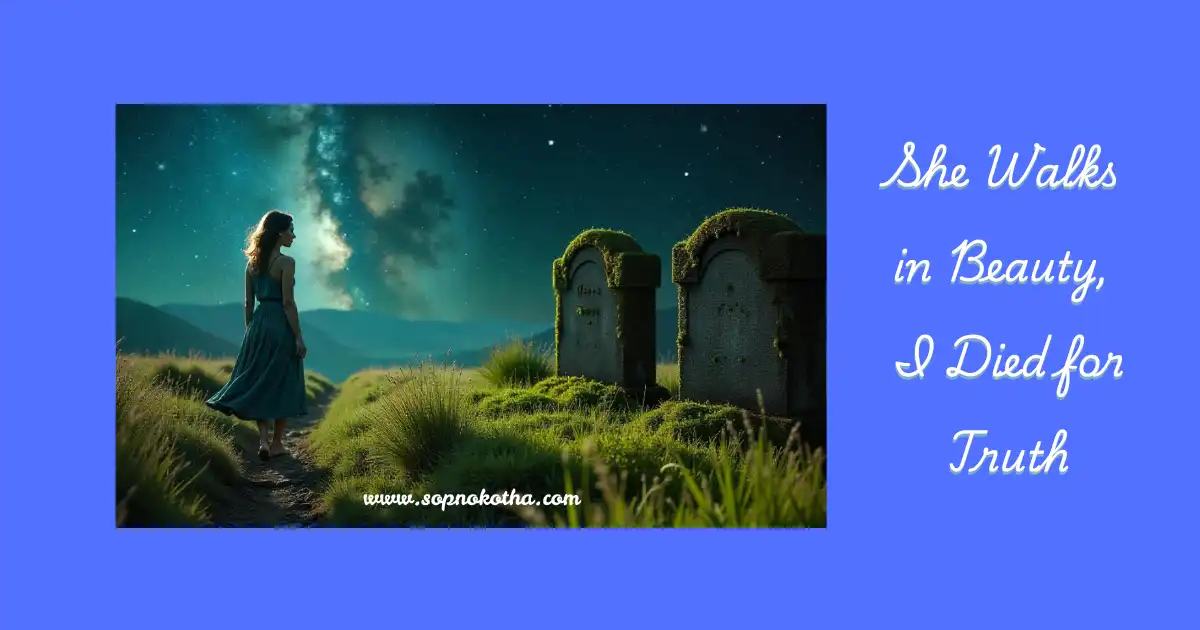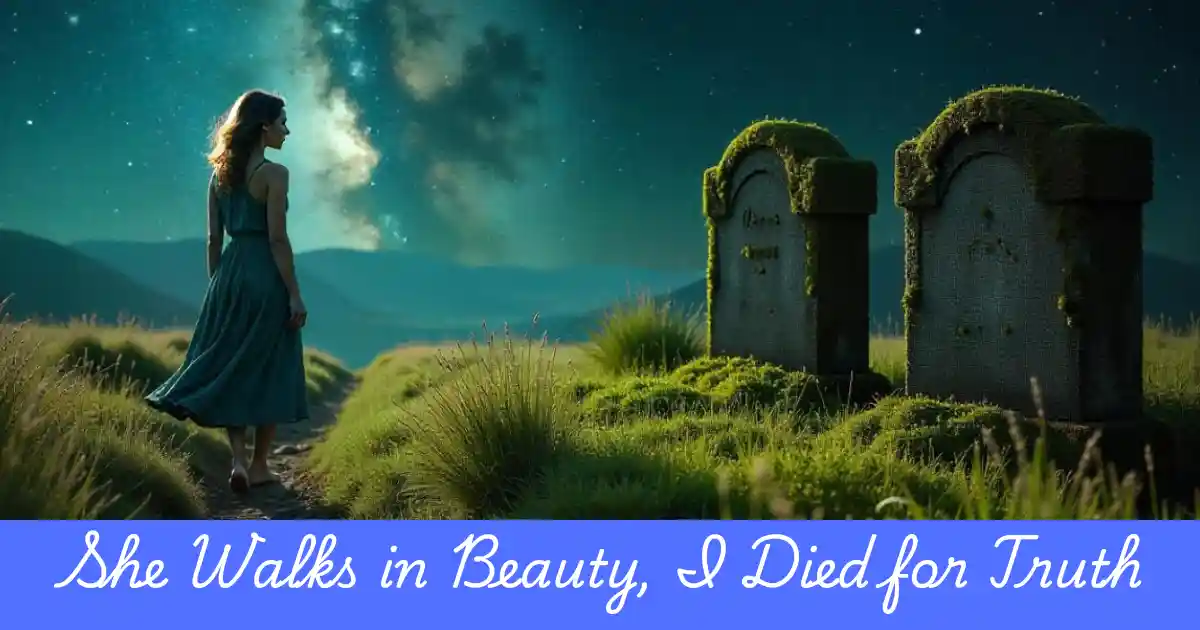Beauty is a timeless concept that has fascinated poets, artists, and philosophers for centuries. We recognize it in nature, human expressions, and even moral acts. Yet, when we try to define beauty, we often struggle. Is beauty objective or subjective? Is it something we see or something we feel?

Read more – Civic Engagement: Education’s Role in Building Best Citizens U1L4
This lesson explores the concept of beauty through a short passage and two remarkable poems—She Walks in Beauty by Lord Byron and I Died for Beauty by Emily Dickinson. While Byron celebrates physical and moral beauty in a woman, Dickinson finds beauty and truth to be inseparably linked. Let’s dive into their poetic insights to better understand this elusive idea.
Beauty is easy to appreciate but difficult to define. As we look around, we discover beauty in pleasurable objects and sights- in nature, in the laughter of children, in the kindness of strangers. But when asked to define it, we run into difficulties. Does beauty have an independent, objective identity? Is it universal, or is it shaped by individual perceptions? Does it truly lie in the eye of the beholder? -we ask ourselves.
Throughout history, poets and artists have described beauty in different ways. Poets make use of words to paint images of beauty, while artists create representations of beauty using their creative faculties. Here are two poems that explore the theme of beauty. While Lord Byron (1788-1824) finds perfect beauty in a woman he idealizes. Emily Dickinson (1830-1886) asserts that beauty is inseparable from truth.
Paragraph-wise Bangla Explanation:
Paragraph 1:
“Beauty is easy to appreciate…” এই অনুচ্ছেদটি বোঝায়, আমরা সৌন্দর্যকে সহজেই উপভোগ করতে পারি, কিন্তু সেটি সংজ্ঞায়িত করতে গেলে সমস্যায় পড়ি। আমরা প্রকৃতির দৃশ্য, শিশুদের হাসি কিংবা অপরিচিতের সদয় আচরণে সৌন্দর্য খুঁজে পাই। তবে সৌন্দর্য কি একটি নিরপেক্ষ, সর্বজনীন গুণ? নাকি এটি দর্শকের ব্যক্তিগত উপলব্ধির উপর নির্ভর করে?
Paragraph 2:
এই অংশে বলা হয়েছে, ইতিহাসে কবি ও শিল্পীরা সৌন্দর্যকে বিভিন্নভাবে বর্ণনা করেছেন। কবিরা ভাষার মাধ্যমে সৌন্দর্যের চিত্র আঁকেন, আর শিল্পীরা তাঁদের কল্পনাশক্তি ব্যবহার করে তা দৃশ্যমান করেন।
‘She Walks in Beauty’
by Lord Byron
She walks in beauty, like the night
Of cloudless climes and starry skies;
And all that’s best of dark and bright
Meet in her aspect and her eyes;
Thus mellowed to that tender light
Which heaven to gaudy day denies.
One shade the more, one ray the less,
Had half impaired the nameless grace
Which waves in every raven tress,
Or softly lightens o’er her face;
Where thoughts serenely sweet express.
How pure, how dear their dwelling-place.
And on that check, and o’er that brow.
So soft, so calm. yet eloquent,
The smiles that win, the tints that glow,
But tell of days in goodness spent,
A mind at peace with all below.
A heart whose love is innocent!
Explanation of Poem 1: “She Walks in Beauty” by Lord Byron
She walks in beauty, like the night / Of cloudless climes and starry skies;
বাংলা ব্যাখ্যা:
এই নারীর সৌন্দর্য এমনভাবে চলাফেরা করে, যেন সে এক মেঘহীন আকাশের নিচে তারায় ভরা কোনো রাত্রির মতো। এখানে ‘night’ ও ‘starry skies’-এর উপমার মাধ্যমে বলা হচ্ছে যে তার সৌন্দর্যে এক ধরনের নীরবতা, কোমলতা এবং জ্যোতির্ময়তা আছে।
And all that’s best of dark and bright / Meet in her aspect and her eyes;
বাংলা ব্যাখ্যা:
অন্ধকার ও আলোর সব থেকে সুন্দর উপাদানগুলো তার চেহারা ও চোখে একত্রিত হয়েছে। তার চোখে যেমন গাঢ়তা আছে, তেমনি আছে দীপ্তি। এই দ্বৈত বৈশিষ্ট্যই তার রূপকে বিশেষ করে তুলেছে।
Thus mellowed to that tender light / Which heaven to gaudy day denies.
বাংলা ব্যাখ্যা:
এই সৌন্দর্য এমন এক কোমল আলোতে পরিণত হয়েছে যা স্বর্গ গৌরবময় দিনে দেয় না। অর্থাৎ, দিনের আলো যতটা তীব্র, এই নারীর সৌন্দর্য ততটাই কোমল, শান্ত, ও পরিমিত।
One shade the more, one ray the less, / Had half impaired the nameless grace
বাংলা ব্যাখ্যা:
তার রূপ যদি অল্প একটু গাঢ় হত বা অল্প আলো কম হত, তাহলেও এই অপরূপ সৌন্দর্য নষ্ট হয়ে যেত। এখানে বোঝানো হচ্ছে তার রূপ এক নিখুঁত ভারসাম্যে স্থাপিত।
Which waves in every raven tress, / Or softly lightens o’er her face;
বাংলা ব্যাখ্যা:
এই অনির্বচনীয় সৌন্দর্য তার কালো চুলে ঢেউয়ের মতো ছড়িয়ে আছে, এবং তা তার মুখের ওপর কোমল আলোয় উদ্ভাসিত। ‘raven tress’ বলতে বোঝানো হয়েছে গভীর কালো চুল।
Where thoughts serenely sweet express, / How pure, how dear their dwelling-place.
বাংলা ব্যাখ্যা:
তার চোখ-মুখে যেসব শান্ত ও মধুর চিন্তার প্রকাশ ঘটে, তা দেখেই বোঝা যায়—তার অন্তর কতটা বিশুদ্ধ এবং দামী (মূল্যবান)। মানসিক ও আত্মিক সৌন্দর্যের প্রকাশ এখানে গুরুত্ব পেয়েছে।
And on that cheek, and o’er that brow, / So soft, so calm, yet eloquent,
বাংলা ব্যাখ্যা:
তার গাল ও কপাল এতই কোমল এবং শান্ত যে, সেখানে কোনো শব্দ না থাকলেও তা অনেক কিছু বলে দেয়। এখানে ‘eloquent’ অর্থাৎ বাক্যবাগীশ শব্দটি দিয়ে বলা হয়েছে—তার মুখাবয়ব নিজেই কথা বলে।
The smiles that win, the tints that glow, / But tell of days in goodness spent,
বাংলা ব্যাখ্যা:
তার মুখে যে মুগ্ধকর হাসি এবং যে দীপ্তি দেখা যায়, তা তার জীবনের মহৎ কাজ এবং ভালোমানুষি জীবনযাত্রার সাক্ষ্য দেয়।
A mind at peace with all below, / A heart whose love is innocent!
বাংলা ব্যাখ্যা:
তার মন পৃথিবীর সবার সঙ্গে শান্তিতে রয়েছে এবং তার হৃদয় এমন এক প্রেম ধারণ করে যা একেবারে নিষ্পাপ। এখানে দেহ-সৌন্দর্যের পাশাপাশি আত্মিক সৌন্দর্যের প্রশংসা করা হয়েছে।

Read more – Simple, Compound, and Complex -Best 7 Powerful Rules
‘I Died For Beauty’
by Emily Dickinson
I died for beauty, but was scarce
Adjusted in the tomb,
When one who died for truth was lain
In an adjoining room.
He questioned softly why I failed?
“For beauty.” I replied.
“And I for truth – the two are one;
We brethren are,” he said.
And so, as kinsmen met a-night,
We talked between the rooms,
Until the moss had reached our lips.
And covered up our names.
[This passage/content is taken from the National Curriculum and Textbook Board (NCTB), Bangladesh English textbook for educational purposes only.]
© NCTB Bangladesh. All rights reserved to the original publisher.
Explanation of Poem 2: “I Died for Beauty” by Emily Dickinson
I died for beauty, but was scarce / Adjusted in the tomb,
বাংলা ব্যাখ্যা:
আমি সৌন্দর্যের জন্য জীবন দিয়েছিলাম, এবং কেবলমাত্র কবরে একটু সামঞ্জস্য হচ্ছিলাম (মানে সদ্য মৃত হয়েছি), এরকম অবস্থায় কবিতাটি শুরু হয়। এটি সৌন্দর্যকে একটি নৈতিক আদর্শ হিসেবে দেখায়।
When one who died for truth was lain / In an adjoining room.
বাংলা ব্যাখ্যা:
একজন ব্যক্তি, যিনি সত্যের জন্য জীবন দিয়েছেন, তাঁকে আমার পাশের কবরে শায়িত করা হলো। এখানে সৌন্দর্য ও সত্য—এই দুটি ধারণাকে পাশাপাশি স্থান দেওয়া হয়েছে।
He questioned softly why I failed? / “For beauty,” I replied.
বাংলা ব্যাখ্যা:
সেই ব্যক্তি (যিনি সত্যের জন্য মারা গেছেন) ধীরে জিজ্ঞাসা করলেন, আমি কেন মারা গেলাম? আমি উত্তর দিলাম—সৌন্দর্যের জন্য।
“And I for truth – the two are one; / We brethren are,” he said.
বাংলা ব্যাখ্যা:
তিনি বললেন, “আমি সত্যের জন্য, কিন্তু সৌন্দর্য ও সত্য তো একই জিনিস। আমরা একে অপরের ভাই।” এখানে বলা হয়েছে যে সত্য ও সৌন্দর্য একে অপরের সঙ্গে অভিন্ন—একটি গভীর দার্শনিক বক্তব্য।
And so, as kinsmen met a-night, / We talked between the rooms,
বাংলা ব্যাখ্যা:
তখন আমরা যেন আত্মীয়রা রাতে দেখা করে—ঠিক তেমন করে কবরে থেকেও কথা বললাম। কবরের ঘরের মাঝখান দিয়ে কথোপকথন ঘটছে বলে বলা হয়েছে।
Until the moss had reached our lips, / And covered up our names.
বাংলা ব্যাখ্যা:
এতদিন ধরে আমরা কথা বলেছিলাম যে, শৈবাল (moss) আমাদের ঠোঁট পর্যন্ত পৌঁছে গেছে এবং আমাদের নামগুলো ঢেকে দিয়েছে। এই লাইনগুলো মৃত্যুর চিরস্থায়ীত্ব এবং সময়ের দ্বারা সব কিছু ঢেকে যাওয়ার কথা বোঝায়।
Relevant Historical Information:
- Lord Byron (1788–1824): একজন রোমান্টিক কবি যিনি সৌন্দর্য ও আবেগকে কেন্দ্র করে কবিতা লিখেছেন। তাঁর কবিতায় নারী-সৌন্দর্যের গভীর প্রশংসা লক্ষ্য করা যায়।
- Emily Dickinson (1830–1886): একজন আমেরিকান কাব্যপ্রতিভা, যিনি সত্য, মৃত্যু এবং আত্মার অনন্ত যাত্রা নিয়ে লেখালেখি করতেন। তাঁর কবিতায় বিমূর্ত ধারণাকে গভীর দার্শনিক দৃষ্টিকোণ থেকে উপস্থাপন করা হয়।
Literary Terms Related to the Poems
Poem 1: “She Walks in Beauty” by Lord Byron
1. Simile (উপমা)
Line: “She walks in beauty, like the night / Of cloudless climes and starry skies;”
Explanation:
Byron নারীর সৌন্দর্যকে একটি তারাভরা মেঘহীন রাতের সঙ্গে তুলনা করেছেন। এটি একটি classic simile, যেখানে “like” শব্দ ব্যবহার করে তুলনা করা হয়েছে।
2. Imagery (চিত্রকল্প)
Line: “And all that’s best of dark and bright / Meet in her aspect and her eyes;”
Explanation:
এই লাইনটি চোখ এবং মুখের সৌন্দর্যের মাধ্যমে আলো ও অন্ধকারের সংমিশ্রণ ফুটিয়ে তুলেছে, যা পাঠকের মনে একটি স্পষ্ট ছবি আঁকে।
3. Alliteration (অনুপ্রাস)
Line: “Day denies” / “cloudless climes” / “serenely sweet”
Explanation:
একই বর্ণ বা ধ্বনি একাধিকবার ব্যবহৃত হয়েছে, যা কবিতাকে শ্রুতিমধুর করেছে।
4. Tone (ভাব বা সুর)
Explanation:
এই কবিতার tone খুব শান্ত, স্নিগ্ধ এবং প্রশংসামূলক। Byron নারীর বাহ্যিক ও অন্তর্নিহিত সৌন্দর্যের প্রতি এক প্রশান্ত ও কাব্যময় দৃষ্টিভঙ্গি প্রকাশ করেছেন।
5. Enjambment (লাইন–ভাঙা ধারাবাহিকতা)
Explanation:
একটি চরণ শেষ না করেই পরবর্তী লাইনে ধারণা গড়ানো হয়েছে—যেমন:
“She walks in beauty, like the night / Of cloudless climes and starry skies;”
এটি কবিতার গতি ও স্বাভাবিকতা বজায় রাখে।
6. Idealization (আদর্শীকরণ)
Explanation:
Byron পুরো কবিতায় নারীর সৌন্দর্য ও চরিত্রকে আদর্শ বা পরিপূর্ণভাবে উপস্থাপন করেছেন, যা Romantic poetry-র বৈশিষ্ট্য।
Poem 2: “I Died for Beauty” by Emily Dickinson
1. Personification (ব্যক্তিত্বায়ন)
Line: “Until the moss had reached our lips, / And covered up our names.”
Explanation:
শৈবালকে এমনভাবে উপস্থাপন করা হয়েছে যেন তা মানুষের মতো ঠোঁট ছুঁয়ে দেয় ও নাম ঢেকে ফেলে—এটি personification।
2. Metaphor (রূপক)
Line: “I died for beauty… one who died for truth…”
Explanation:
এখানে ‘beauty’ ও ‘truth’ কে মানুষ হিসেবে উপস্থাপন করা হয়েছে, যারা কথা বলে এবং কবরে পাশাপাশি থাকে। এটি একটি শক্তিশালী রূপক।
3. Symbolism (প্রতীকায়ন)
Explanation:
– Beauty প্রতীক হয়ে দাঁড়িয়েছে সৌন্দর্যের জন্য আত্মত্যাগের।
– Truth প্রতীক সত্যের জন্য সংগ্রামের।
– Moss প্রতীক সময় ও বিস্মৃতির।
– Tomb বা কবর প্রতীক মৃত্যুর সমতা ও নিস্তব্ধতা।
4. Tone (ভাব)
Explanation:
এই কবিতার tone অনেকটা দার্শনিক, নিঃসঙ্গ ও ধ্যানমগ্ন। Dickinson জীবনের অর্থ, মৃত্যু ও আদর্শ নিয়ে চিন্তা করেছেন।
5. Irony (বিদ্রূপ)
Explanation:
দুজন ব্যক্তি সৌন্দর্য ও সত্যের জন্য জীবন দিয়েছেন, কিন্তু শেষ পর্যন্ত তারা কেউই স্মরণীয় থাকেন না—তাদের নাম শৈবাল ঢেকে দেয়। এটি একটি ট্র্যাজিক irony।
6. Theme (মূল ভাব)
Explanation:
– Beauty ও Truth একে অপরের পরিপূরক
– আদর্শের জন্য আত্মত্যাগ
– মৃত্যুর স্তব্ধতা ও বিস্মরণ
– মানবিক সম্পর্ক এমনকি মৃত্যুর পরেও থাকতে পারে
Bonus Comparison:
| Literary Term | Byron’s Poem | Dickinson’s Poem |
| Simile | Present (like the night) | Not used explicitly |
| Metaphor | Implied in beauty descriptions | Strong metaphor of death for ideals |
| Imagery | Starry skies, calm light | Moss, tombs, whispering between graves |
| Tone | Calm, admiring, romantic | Quiet, melancholic, philosophical |
| Symbolism | Beauty = Innocence, Peace | Beauty & Truth = Idealism, Death = Silence |
| Irony | Absent | Strongly present |

Read more – She Walks in Beauty by George Gordon Byron – Poems
5 Short Questions on the Passage (Introductory Part)
- Why is it difficult to define beauty?
- What are some examples of beauty found in our surroundings?
- What question does the passage raise about individual perception of beauty?
- How do poets and artists try to express beauty?
- According to the passage, how does Emily Dickinson relate beauty to truth?
5 Short Questions on the Poem “She Walks in Beauty” by Lord Byron
- What does the poet compare the woman’s beauty to?
- What qualities meet in the woman’s “aspect and eyes”?
- How would “one shade the more, one ray the less” affect her beauty?
- What do the “smiles” and “tints” on her face tell us about her life?
- How does the poet describe the woman’s heart and mind?
5 Short Questions on the Poem “I Died for Beauty” by Emily Dickinson
- Why did the speaker in the poem die?
- Who was laid in the adjoining room of the tomb?
- What does the other person in the poem say about truth and beauty?
- How did the two speakers communicate after death?
- What covered their lips and names in the end?

